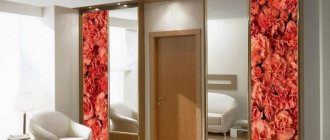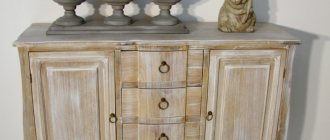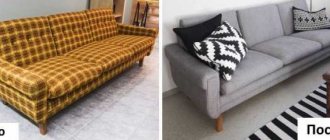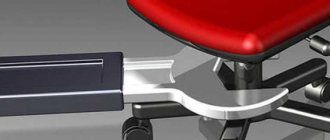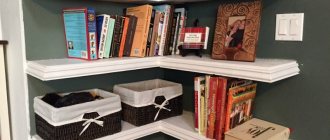Types of door curtains
There are several varieties.
Blinds
A variety of vertical, horizontal blinds or pleated curtains provide an excellent opportunity to bring some airiness and spaciousness to the room.
This solution is not only very original, but also extremely functional.
Hanging curtains
They are quite effective hanging decor, especially suitable for decorating a doorway. Rope interior hanging curtains made of thin sticks or glass beads add brightness, color and unusualness to the environment.
Rolled
They are a very compact design in the form of a textile fabric attached to a special roller.
Roller blinds have a fairly wide range of applications, which makes it interesting to experiment and play with the interior.
Roman
They are a simple, but at the same time very elegant and functional decorative element that goes well with almost any room design.
Drapes and curtains
A standard design solution that is always quite relevant. Due to the wide variety of colors and textures, interior drapes and curtains fit particularly harmoniously into the overall interior concept.
Hourglass
Fixed at the bottom and top, the textile fabric is intercepted in the center using a ribbon or any other decorative device, which gives the curtains an unusual silhouette, similar to an hourglass.
Japanese
Such screen panels, similar to a screen, simultaneously represent both a harmonious interior detail and the semantic center of a style composition.
Hanging curtains for the doorway
In the recent Soviet past, when the country was experiencing a commodity shortage, such curtains were in almost every home. They were made with their own hands from scraps of bamboo, plastic tubes, colored postcards and paper clips. Hanging curtains are light and airy, allowing air and light to pass through perfectly, making the room unique and fresh.
Pebble curtains
Currently, there are much more materials for making such curtains than in Soviet times. For lovers of crafts made from natural materials, curtains made from natural wood cuts are quite suitable. To do this, you should choose wood with a beautiful texture: cherry, apple tree, oak, birch. A sufficient number of branches of the same diameter are selected, which are then sawed together with the bark into flat dies. Holes are made in the wooden round on both sides, into which rings made of durable plastic or metal are inserted. Wooden circles are alternately strung on chains, threads or cords.
Important! The wood can be coated with a colorless wood varnish, which will preserve the beauty of the texture.
Colored feathers of decorative birds are perfect for hanging curtains: such a curtain perfectly decorates any interior, giving it a fabulous charm.
Features of using curtains
A few main points:
- To visually expand the room, it is appropriate to use light, light and flowing fabrics, such as veil or organza.
- Curtains of a dark and deep shade will help correct the disproportionate width of the room.
- Interior canvases with small prints will visually expand the spatial boundaries, and products with large patterns, on the contrary, will narrow them.
- In small rooms it is not advisable to use heavy and complex curtain compositions with draperies.
Options for using curtains for openings
Two ways to use:
- Instead of a door. The canvases used instead of doors are more decorative than functional. They do not overload the decor, give the room a freer look and make it much more comfortable.
Symmetrically or asymmetrically picked up interior curtains will not interfere with free passage.
- On the door. This placement is especially suitable for door structures with glazing. In this case, curtains will help block unnecessary views and make the environment more personal and secluded.
Thanks to a variety of fashionable textiles, you can perfectly complement and decorate any interior. Curtain ensembles not only add coziness to the space, but also make its image more complete.
Why should you give up the door?
Before giving life to creative and non-standard ideas, their owner weighs all the pros and cons. Convinced of the correctness of his decision, he begins the process of implementation. Are you still in doubt?
Explore all the advantages of a doorway without doors, and the solution will not keep you waiting long.
- Designing a doorway without a door is much more economical than installing a door leaf.
- Doorways can be of various shapes: in the form of an arch, trapezoid. It is problematic to purchase doors of this shape.
- There is a wide selection of materials for finishing the opening. It can be plastic, wood, glass, forging, drywall (used mainly for shaped openings), textiles. The absence of a door in the opening visually increases the space.
- Expansion of territory is indispensable for practical purposes. When installing doors in openings, you should be very careful about the planned area, because it is important to take into account the fact that the door should open and close freely. And these are all square meters, which, as usual, are not enough.
- Curtains on the door are a hit of modern design. They make the room cozy and comfortable, radically change its external image, transforming and making its entire territory stylish and original. Discover curtains for a doorway, and the small decorative details that make up the curtain will make the room unforgettable for guests, interesting and comfortable for you.
Pros and cons
Before making a curtain for the door, we suggest you familiarize yourself with some of the advantages of such a solution:
- Using curtains, you can visually adjust the size of the room - reduce or enlarge it. You can achieve this effect using the appropriate color of the product.
- Possibility of using different materials. It can be textiles, wood or threads.
- Curtains bring a certain lightness to the interior.
- Saving usable space, which is especially important in small apartments. On average, a swing door requires 1 m2 of space, and when installing curtains, this problem is eliminated.
- Save money on purchasing a high-quality interior door. Even the most expensive curtains are cheaper than doors.
Related article: How to replace the cylinder in a door lock
Like everything else, curtains installed on a doorway have their drawbacks. Among them, it is especially worth noting the insufficient heat and sound insulation. In view of this, the choice is between beauty and practicality.
Some people install a door, on the opening of which they then hang curtains. Some designers fully justify this option, especially in cases where the room has an old door that is not in harmony with the overall concept of the interior. This combination is quite logical when arranging a balcony doorway.
Advantages of interior curtains
You can update the decor in a room without radical renovations using textile decoration.
Curtains on the doorway have a number of advantages:
- Decorating a doorway with textiles is easier and cheaper than installing a door block.
- It is problematic to select doors and extensions for a non-standard, complex opening. Curtains are an alternative solution to the problem.
- Curtains “breathe” and allow air to pass through.
- Ideal for arched openings.
Door curtains in walk-through rooms should be equipped with magnetic hooks so as not to move them apart with your hands. The fabric will become less dirty and pass through the opening more conveniently.
Disadvantages of using an open doorway
- If you make a comparison between the absence and presence of a door in the opening, then there will definitely be a category of people who will see more disadvantages than advantages. Therefore, instead of door curtains, they will prefer the standard option.
- Lack of space demarcation line. For example, you have an arch connecting the kitchen area and the hallway. The absence of a door in this case is more of a minus than a plus.
- Visually, the room does not become larger, and the smells and soot from cooking easily penetrate the rooms. The presence of doors between these two areas delays the spread of odors.
- Limited installation. Some categories of rooms, such as a bathroom or restroom, personal office or bedroom, do not accept open openings. The owners of these rooms will definitely prefer doors instead of curtains.
- Lack of a state of unity and individuality. Very often, newlyweds live in the same area as their parents. How to leave a passage without a door? This possibility is excluded.
Wooden door curtains
Curtains made from wooden elements have many advantages.
- Eco-friendly and natural.
- Beautiful.
- Place the “right” accents in the room.
- Organic for any style.
- Natural color.
- Form diversity.
- Assortment of textures and types of weaving.
- Simple and convenient.
- Can be painted any color you like
- Wooden curtains for the doorway are a version of curtains that combines wooden beads and threads, subtly emphasizing the naturalness of the wood and the originality of the threads.
- Bamboo door curtains will also not leave connoisseurs of a “green” lifestyle indifferent.
- Their basis is environmentally friendly material.
- Gives a luxurious look to the entire room.
- Helps create an atmosphere of calm.
Do you like the east? Are you close to African style? Interested in the tropics and jungles?
Stop for a moment and look at the bamboo curtains for the doorway.
Main types of curtains. Design Features
Initially, all types of curtains and drapes are divided according to their purpose:
- Instead of a door - a complete replacement of the interior door and fixation to the opening.
- Together with the door - additional protection from large amounts of sunlight, decorative design in order to give the room coziness, romance and charm.
There is also a classification depending on the material used for manufacturing:
- fabric - a wide variety of textiles are selected (satin, silk, linen, velvet, satin and others);
- wooden – consist of wooden elements of different shapes;
- thread - an airy product, which includes a huge number of threads, which gives airiness to the room;
- glass - as in the case of wooden curtains, any glass beads (including beads) are strung on a fishing line.
Note!
Curtains made of bamboo will look original.
When considering these options, it is worth considering that each material, its shape and color, will affect the change in the room. Therefore, if combined incorrectly, you can introduce disharmony into the interior. Consider the following recommendations:
- To visually increase the space, use light flowing fabrics in light and pastel shades.
- You can narrow a room using deep and dark tones.
- Small elements will expand the space, and a large print will narrow it.
- A vertical stripe on the fabric will increase the height of the ceiling, and a horizontal pattern will widen the opening.
- A small room should be decorated with transparent and light curtains.
- The incorrect geometry of the room can be corrected by a curtain on an asymmetrically shaped doorway.
When developing a curtain design for a doorway, it is necessary to take into account many factors. The most basic ones are the style of the room and the main purpose of the curtain. Thus, the type of design must fully correspond to the style of the created interior.
- In a classic interior, the use of textiles is preferable. When choosing dense fabrics, decorate them with tiebacks with tassels or lambrequins.
- For minimalism or hi-tech, curtains with eyelets are perfect.
- Elegant and airy thread curtains are used in retro and oriental styles.
- Curtains made of wooden elements look harmonious in the interior of country and Provence styles.
- The interior in a modern direction is often complemented by curtains made of beads.
Note!
In large rooms with several doorways, you can use the same curtains or completely different ones.
Filament curtains
Door curtains made of threads are a very popular type of “tool” for zoning and dividing space. No type of curtain for doorways makes a room as bohemian as rope curtains. Their structure (threads are obtained synthetically from viscose fiber or polyester) can be thin or thick, in one or more weaves, in a variety of colors and shades.
Their mission is to darken the room without interfering with the flow of fresh air.
Rope curtains most often take the form of thin threads, combined into strong rope strands, and making up a single thread tape. There are threads combined with sequins, glass beads, and beads. Instead of standard thread curtains, a unique opportunity has appeared to become the owner of exclusive curtains. Hanging threads “play” with every breath of wind, making the room airy and fresh. Recently, feather pendants have been gaining momentum.
Light chic and effortless luxury is what will fill the room if you decorate the opening with the help of a “hanging curtain” on the doorway.
Master class on making curtains from threads with your own hands
To make curtains from threads for doorways, you will need threads made of silk, viscose, polyester or twine, of different thicknesses, colors and weaving. In addition to the warp threads, you can use decorative elements: beads or glass beads. The choice of material depends on the interior of the room and the aesthetic preferences of the apartment owner.
First you need to calculate the need for material (threads), for which you measure the dimensions of the openings.
Important! When taking measurements, it should be taken into account that the curtain should extend slightly onto the walls.
After determining the dimensions of the doorway, you should determine the distance between the individual threads. The length of one thread should be calculated taking into account the allowance for tying knots on the top bar. The bar for hanging threads can be made of different materials: metal, wood, plastic, bamboo. Sometimes holes are drilled in the bar to pull the warp threads through, sometimes the threads are tied by directly attaching the knot to the bar.
Choose heavy and durable threads for curtains
In the upper part of the curtain, threads can be woven to increase decorative qualities, without forgetting to provide an additional length of thread. You can place decorative beads made of wood, glass or plastic in the weaving knots of the threads, which need to be prepared in advance. The beads can match the main threads in tone, or they can stand out in color, creating additional bright accents.
The beads are secured using knots or additional fittings. It is best to trim the bottom edge of thread curtains with a row of beads - this will allow the threads to hang strictly vertically. Thread curtains harmonize perfectly with any interior. Made with your own hands from decorative threads of various weaves, curtains help create unique comfort and decorate a unique interior.
Color range of interior curtains
Thanks to a wide range of colors, you can emphasize all the interior sophistication, create a truly memorable and expressive design and place the necessary accents in the room.
For curtains, choose colors that are in harmony with the main decoration, and vice versa, brighter and more contrasting colors.
Examples of interior curtain design
Original design solutions for curtains.
Straw rings
- They are distinguished by their affordable price, practicality and reliability. Straw rings add texture to the interior and are perfect for rooms that do not require complete insulation.
- Bamboo door curtains are suitable for those who especially value natural materials, natural beauty, warmth, comfort and eco-design.
Beads
- They are quite an exotic option for interior curtains and an extraordinary decorative element that brings special romance to the interior and fills the room with sparkling reflections.
With cornice
- Canvases on a cornice, mounted on a wall or ceiling, are considered the most common solution with a neutral stylistic meaning.
On the eyelets
- They are distinguished by their ease of movement and the beautiful appearance of the folds created during draping. The eyelets can be used equally well to secure both heavy curtains and weightless curtains made of organza, tulle or veil.
Macrame
- It becomes a very interesting interior decoration that you can create yourself, without extra costs. The unique crochet weave will undoubtedly add exclusivity to the design.
Design options in various styles
Depending on the style direction of the room, you can choose certain curtains that will highlight the decor and harmoniously complement the overall design idea.
- Provence.
- Modern.
- Classic.
- Country.
- Oriental.
Thanks to a variety of curtain ensembles, the style of the room becomes more complete and harmonious, and the room itself is filled with lightness and airiness.
Classic design trends - Renaissance, Baroque, Neoclassicism, Victorian style, Art Nouveau. The interior design includes elements that emphasize luxury, a certain imperial pomp, and are complemented by intricate decor.
Interior curtains reflect these stylistic features. Classic canvases and complex curtains will fit organically into the interior. Arched openings and bay windows are a characteristic element of classicism. They can be decorated using Italian canvases. Decorations in the form of tiebacks, decorations such as tassels, and fringes are appropriate.
The bay window is zoned using curtains and curtain fabric, which duplicate the color and style of the curtains on the windows. To decorate doors with glass, hourglass-type canvases are appropriate.
The background color is mainly used in the range of white and beige. Window and door curtains are made from fabrics with contrasting colors. They use shades of burgundy, green, and blue. Splashes of gold in the decor are appropriate.
Hidden decorated ceiling cornices, wooden, metal with carved tips, will organically fit into the ensemble.
Minimalism
- Other techniques are used to design a doorway in the style of minimalism. Laconicism, rigor, simple lines are characteristic features of high-tech, fusion, postmodern, techno.
- Curtains, blinds, rims, and Japanese screens naturally fit into the interior. Fabric sheets of simple shape are hung on string, chrome-plated cornices.
- Light colors, a range of beige, coffee tones, or pastel shades of other colors predominate.
"Home" styles
- They focus on creating comfort and coziness in the interior. These include styles: Provence, shabby chic, country, chalet. Textile design plays a significant role in design.
- Door curtains made of light natural fabrics with patterns look good in such interiors. Canvases with ruffles, flounces, and bows create an atmosphere of home comfort.
- Wooden and metal curtain rods are used for Italian, crossed, classic curtains with decor.
Curtains for the door in ethnic style
The national style is quite diverse, absorbing elements and features of national coloring.
- Oriental, Indian, Moorish style is a play of bright, rich tones in the curtains on the doorways. Due to the hot climate, curtains are rarely sewn from thick, heavy fabrics. Lightweight, highly breathable materials are used. These include organza, natural silk fabrics, and mesh materials.
- Japanese minimalism requires the use of natural materials and natural tones. Curtains for the doorway are also selected in this vein. These are primarily Japanese screens, as well as curtains made from natural materials: straw, bamboo, special paper.
- Scandinavian interiors value simplicity of decoration combined with functionality. Door curtains are made from natural fabrics, linen, matting, in neutral light colors. Mostly they hang simple classic curtains, or cross curtains on wooden cornices and eyelets.
Magnetic curtains for the doorway with mosquito net
- Although this type of mosquito curtains has recently appeared on the market, they have already gained popularity. 2 mesh fabrics are stretched over a soft frame. A magnetic strip is inserted on the side of the separation of the canvases. Easily attached to the doorway using double-sided tape.
- The range of magnetic curtains is constantly expanding. Models with photo printing appeared. Install mosquito curtains on the entrance doors, in the opening of the hallway, summer kitchen, and balcony.
- The advantage of mosquito nets is that they are practical to use. They are easily moved apart at the moment of passage. The canvases automatically close together thanks to a magnetic tape.
Types of curtains for doorways
Today, manufacturers offer a wide range of products for decorating door and arched openings. Some of the most popular options are the following types of curtains:
- Made from natural bamboo – these curtains made from natural material are environmentally friendly, strong and durable. They fit perfectly into any interior thanks to the soft and warm range of colors. Curtains do not fade when exposed to sunlight, do not accumulate static electricity, and are easy to wash and clean. Bamboo curtains are suitable for rooms designed in a classic or oriental style, as well as in country style.
Bamboo curtains
- Plastic curtains are quite impressive and inexpensive products, which are available in a wide range of colors and suit almost any interior. Curtains made of plastic slats, which can be adjusted both horizontally and vertically, are distinguished by their low weight and a variety of decor. They are easy to care for. The disadvantage of plastic curtains is fading and fragility under the influence of ultraviolet radiation, low strength and fragility.
Plastic curtains
- Thread curtains - these products can be absolutely unique thanks to glass beads, beads, seed beads, feathers and other decorative elements that are hung on vertical warp threads. The coloring of thread curtains can be in a wide range; you can always choose the ideal option for the interior of the room. Thread curtains are easy to wash, but it is worth noting their short service life.
Thread curtains
- Curtains made of small pendants (a type of thread curtains) are a design made of vertical threads on which colored pebbles, shells, beads, pieces of wood and other finishing elements are alternately strung. Such curtains are easy to make with your own hands, adding original and unique elements to the interior decoration. Especially often, when making curtains from pendants, hanging beads, appliqués, and short wooden tubes are used.
Curtains made of small pendants
- Roller blinds are a whole mechanism consisting of the curtain itself, a casing and a control mechanism. The most modern type of curtains for the door leaf. They fit perfectly into any interior; the curtains are reliable and durable.
Roller blinds
How to hang curtains on doors and open passages?
Choose a cornice for the door curtain so that both elements are combined and complement each other. Take into account the general style of the room. The planks come in ceiling and wall mounting types.
- For modern style, it is preferable to use metal cornices with a chrome finish. Blinds are usually attached to such a bar. White cornices match the plastic windows, emphasizing the modern style.
- In a room with a rustic style, they decorate the doorway with a bamboo curtain, and attach it to a wooden cornice or a homemade plank. Wood goes well with straw pendants.
- Thread curtains in an open opening can be hung on a cornice to make them slide to the side. The ropes will not interfere with free passage even if they are securely fixed through the holes on the wooden plank.
Decorating the passage of an interior partition with curtains is most often done independently in order to save money. Although experienced designers also use this technique.
Sewing an elegant fabric curtain
Fabric is the most common way to decorate a doorway. To make it also unusual, it is better not to purchase standard options, but to do everything yourself. Before work, you need to draw a sketch and take into account the number of frills and lambrequins. Based on this, calculate the required fabric footage. For example, drapery doubles the footage.
Attention! The width of the curtain is calculated by the formula: the width of the cornice multiplied by the gathering factor (from 1.8 to 3x depending on the type of fabric), plus seam allowances.
Materials:
- textile;
- threads, needle;
- sewing machine;
- threads to match the material, braid.
Curtains made of ribbons with beads
Action steps:
- Prepare the fabric: wash and dry.
- Process or remove edge.
- Cut according to the sketch.
- Sew the curtain using a sewing machine according to the pattern.
- Fold and sew loops at the top.
- Place on the rings of the cornice.
To ensure that the curtain does not block the entrance to the room, you can install tiebacks and use them to hold the open curtains.
A product made of thread, bamboo or fabric will delight your family and surprise your friends, and it can serve for over 5 years.
The location of the opening matters
It is unlikely that anyone would argue that it is textiles that make a room cozy - even if there is little furniture in it and it has the simplest design. The same goes for wall decoration: it can be neutral, without any decor, but well-chosen curtains can enliven the interior and make it memorable.
And this applies not only to window textiles; you can just as easily hang curtains in the doorway.
Opening in the living room
- Apart from the nuances regarding the regulation of light in the room, curtains for doors are selected according to the same principles as for windows. Moreover, often the same curtains are hung on them.
- For some styles this is the most correct solution. But here a lot depends on where the opening is located and what the purpose of the room behind it is.
- This will look good if the room is a walk-through room and has several openings, or if there is an exit to a terrace or balcony next to the window.
We have presented several photos where the same curtains were hung on both the window and the doorway:
But, of course, everything is very individual, since each room has its own geometry. If it is correct, that is, when the opening is strictly opposite the window - or next to it and is proportional to it in size, the option with identical curtains will always be appropriate.
Opening at the entrance or in the corridor
However, curtains are not always chosen for a doorway without a door. A curtain can also decorate an opening with a door: either an interior door or one opening onto a terrace, which, as a rule, is glass, or at the entrance to the house.
The latter option is usually used instead of a second door, or simply as decorative curtains on a doorway.
- Functionality as such is not required here, except that sometimes there is a need to protect your home from the invasion of insects, which inevitably rush inside when the doors are open.
- In this case, curtains with magnets are hung at the entrance, or even door mosquito nets are installed. But for our latitudes this is a purely seasonal decision, and we are talking about decorativeness, which should constantly please the eye.
- As a “two in one” option - on the front door, or in the corridor separating the vestibule from the hall, you can hang wooden curtains on the doorway - or rope (thread) curtains.
Note: As practice shows, hanging curtains in a doorway can be called protection against insects with a big stretch. And to be honest, from an aesthetic point of view, wooden curtains are much inferior to well-chosen and beautifully picked up textile curtains. Unless you are decorating the interior in an eco-style - then wood and bamboo will be most appropriate.
Fabric selection
This is the most crucial moment, since the shade, texture and type of fabric pattern must be linked not only with the decoration of the walls and the purpose of the premises, but also with the dimensions and style of the furniture, as well as the colors of all other fabrics - from upholstery to flooring.
Be that as it may, when selecting textiles for openings, you need to follow several general rules.
So, a small but very useful guide to choosing curtain fabric:
- If you have to fit a curtain into an already finished interior, it will be easier to do this if the fabric is one color and without a pattern. Its beauty can well be expressed by its workmanship and texture.
- When giving preference to patterned fabric, it is necessary to take into account the scale of the pattern or the nature of the image, linking it with both the style of the furniture and the pattern on the carpet.
- Fabrics with patterns and wallpapers with patterns can, of course, be combined, but it is very important to observe the measure. In a small room, too many different patterns will create the impression of cacophony.
Advice: If you really want to use a cheerful pattern in your interior, it is better to purchase wallpaper and accompanying fabrics for curtains. Well-known manufacturers often offer them as a kit. In the interior, this combination looks simply great, although the price is quite high. Such a solution might look something like this:
- The arrangement of two or more types of fabrics: on one opening, on doors and windows, in other types of textiles, can be carried out either according to the principle of similarity or in contrast.
- In the first case, one of them should dominate, and all the others should only complement it. In this case, the shades can be different, but either from the same spectrum or from the tones closest to a given color.
- In the second case, additional shades may stand out against the general background with a more saturated color, graphic pattern or bright design.
- Note: However, we note that rich colors and eye-catching designs are appropriate only in halls, living rooms, and kitchen-dining rooms. For the bedroom, it’s still better to choose something calmer.
- By choosing a fabric with a stripe or a small pattern arranged in rows, you can visually adjust the geometry of the room. If you place the stripes vertically, the ceiling will visually become higher. With horizontal stripes, both the opening and the room itself will look wider;
You can sew decorative curtains for the doorway with your own hands from textured fabric. Their color is always deeper and richer, since the multi-level interweaving of threads creates an interesting play of light and shadow.
In addition, textured materials are characterized by velvety and softness, and they go well with everything that can be found in a modern interior: leather, metal, polished wood.
Stylized fabrics with deep relief, pronounced geometric patterns, stripes and checks are best suited to interiors decorated in ethnic styles.
Advice: Do not try to install heavy draperies in the openings, which only collect dust.
The only exceptions are those cases when the room is decorated in one of the historical styles that include similar concepts. Modern salons can offer excellent design solutions for creating volumetric compositions that will look unusual in the interior and will decorate it very much.
These curtains are difficult to care for, but they are an integral part of many historical and vintage styles.
Tip: You should especially not get carried away with pile or textured fabrics if the doorway leads to the kitchen, nursery or terrace.
This is where curtains get dirty the fastest, so it is better to give preference to functionality rather than decorativeness. And if you want to make an accent on the curtain, pay attention to a more careful choice of shade or pattern.
Pros of the solution
If we do not take into account some situations in which the use of conventional standard solutions is impossible for some reason or there is a desire to use curtains specifically, then the remaining positive qualities of curtains will look like this:
- Any size opening can be fully closed. Privacy is still important, even in this situation.
- Even expensive fabric will cost much less than the simplest door.
- You can choose the curtain material, its color and come up with a special model - with drapery, ruffles and whatever else you like. Some options for what curtains look like instead of a door are shown in the photo in this article. There are a lot of options and choosing the most suitable one is perhaps even more difficult than implementing everything.
- Vertical folds in the material will create a visual effect of increasing the height of the opening - in some cases this is very important.
- Space is saved.
- If you wish, you can always replace the material - any curtain that you plan to use instead of a door can easily be created with your own hands.
- For small apartments or studios, this solution will be one of the best - you add the ability to close the opening and at the same time do not block it completely, leaving the space almost free.
- If you think about the configuration of the curtain, you can give the textile design any shape - from a simple rectangle to triangular or arched options.
- Using translucent materials, you get the opportunity not to limit the light flux by a blank door leaf, leaving access to light even when the curtains are closed.
Even if you don’t like the curtain installed instead of the interior door after some time or you need to remove it, it will be easy to do. There are practically no traces of installation left and the door can always be returned to its place.
